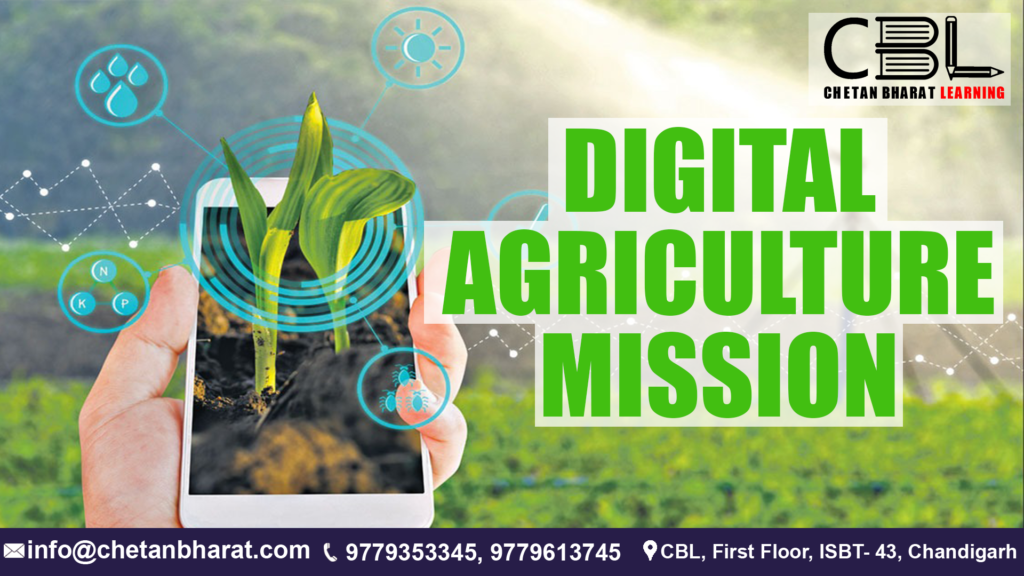
Important for UPSC, State PCS
Prelims: Digital agriculture mission . Green revolution , Pradhan Mantri Fasal Bima Yojna (PMFBY)
Mains: General Studies Paper 3 , Significance of Digitisation of Agriculture Sector and E-Technology for Farmers
Why in the news ?
The Union Cabinet Committee recently approved the Digital Agriculture Mission. with a budget of Rs. 2,817 Crore, including a central government share of Rs. 1,940 Crore.
About Digital Agriculture Mission
1.The Digital Agriculture Mission is an umbrella scheme supporting digital agriculture initiatives in India.
2. It focuses on developing Digital Public Infrastructure, implementing the Digital General Crop Estimation Survey (DGCES), and advancing IT projects by government bodies and research institutions.
3. It is aligned with the “Viksit Bharat@2047” vision.
4. It aims to create a sustainable and digitally empowered agriculture sector.
Aim –
It aims to create Digital Public Infrastructure (DPI) for agriculture, facilitating data-driven decision-making and digital services for farmers
Components of Digital Public Infrastructure (DPI)–
1. AgriStack: A comprehensive digital platform to provide efficient, faster, and easier services to farmers. It includes three foundational registries: the Farmers’ Registry, Geo-referenced village maps, and the Crop Sown Registry.
2. Krishi Decision Support System (Krishi-DSS): A geospatial system that integrates data on crops, soil, weather, and water resources to support decision-making in agriculture.
3. Soil Profile Mapping: Detailed soil profile mapping at a 1:10,000 scale covering approximately 142 million hectares of agricultural land in India
Digital Identity for Farmers–
1. Under AgriStack, a digital identity (Farmer ID) will be provided to farmers, similar to Aadhaar, called ‘Kisan ki Pehchaan’.
2. This ID will link dynamically to various data points such as land records, livestock ownership, crops sown, and demographic details
Benefits for Farmers and Stakeholders–
1. Farmers can access services and schemes digitally, reducing the need for physical visits to government offices and minimizing paperwork.
2. The digital infrastructure will facilitate efficient service delivery mechanisms, such as paperless MSP-based procurement, crop insurance, credit-linked crop loans, and balanced fertilizer use.
3. The Digital Agriculture Mission will enable the development of efficient value chains for agricultural inputs and post-harvest processes.
4. The mission is expected to generate both direct and indirect employment in the agriculture sector.

About Digital General Crop Estimation Survey (DGCES)–
1. The Digital General Crop Estimation Survey (DGCES) is a nationwide effort to accurately measure crop yields for various crops in India.
2. It is a component of the Digital Agriculture Mission which seeks to establish a strong Digital Public Infrastructure (DPI) for the agriculture sector.
3. It aims to make reliable agricultural production estimates, supporting policy formulation and resource allocation.
4. The DGCES will provide accurate yield estimates using scientifically designed crop-cutting experiments.
Challenges for effective implementation–
Language barriers: Unavailability of varied local languages for technology interface creates barriers in access
Fragmentation of agricultural land: The average landholding in India is only 1.08 ha, making application of present technology difficult as it is conducive for large farms.
High initial costs: Digital agriculture requires significant computing, storage and processing power which makes it less scalable due to high costs.
Lack of sufficient research: The impact technology can have on Indian farming and clarity on profitability is lacking.
Inadequate infrastructure: Digital infrastructure development is lower in rural areas which can be a hindrance to digitization of agriculture. E.g. lower internet penetration
Lack of digital literacy: It hinders adoption of digital technologies as farmers have lower trust in newer systems. It also hinders effective maintenance and grievance redressal related to modern equipment.
THE KEY FORWARD:
Addressing Data Privacy and Security Concerns: Implement robust data protection policies and educate farmers about data rights. The proposed Personal Data Protection Bill in India could be tailored to include specific provisions for agricultural data protection.
Integrating Traditional Knowledge with Digital Solutions: Incorporate local and traditional farming knowledge into digital platforms. The IFFCO Kisan Sanchar Limited (IKSL) initiative combines traditional knowledge with modern technology by providing voice-based agricultural advisory services to farmers.
Enhancing Extension Services through Digital Means: Train agricultural extension workers in digital technologies to better support farmers. Extension workers can act as intermediaries, helping farmers adopt and use digital tools effectively. The e-National Agriculture Market (e-NAM) has trained over 200,000 farmers and traders in using the digital platform for agricultural trading.
Developing User-Friendly Interfaces: Create intuitive, easy-to-use digital tools that cater to varying levels of digital literacy. The Kisan Suvidha app, developed by the Indian government, provides a simple interface for farmers to access weather forecasts, market prices, and plant protection information.
Addressing Affordability Issues: Provide subsidies or low-cost financing options for digital tools and devices. The Indian government’s PM-KISAN scheme, which provides direct income support to farmers, could be expanded to include subsidies for digital devices or data plans specifically for agricultural use.
Enhancing Infrastructure and Connectivity: Invest in rural broadband and mobile connectivity infrastructure. Poor internet connectivity in rural areas is a significant barrier to digital adoption. As of 2021, only 32% of rural India had internet access. The BharatNet project aims to connect broadband to all 250,000 Gram Panchayats in India. As of 2021, it had connected over 156,000 Gram Panchayats, significantly improving rural connectivity.
CBL Practice Questions for Prelims
Which of the following statements is true regarding the Digital Agriculture Mission?
A) It is limited to urban farming.
B) It aims to digitize the entire agricultural value chain.
C) It does not involve any private sector collaboration.
D) It focuses only on cash crops.
Answer: B) It aims to digitize the entire agricultural value chain.
CBL Mains Practice Question
Assess the role of the Digital Agriculture Mission in transforming Indian agriculture. What are its implications for farmers’ livelihoods ?




Leave a Reply
You must be logged in to post a comment.